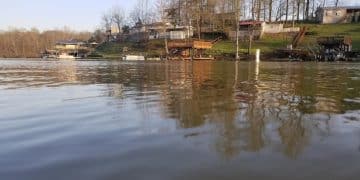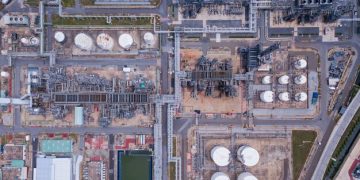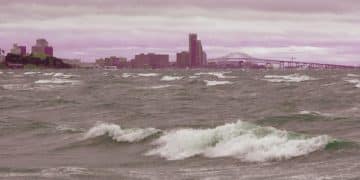Economic Costs of Climate Change: New US Estimates

The economic costs of climate change in the US are estimated to be substantial, impacting various sectors with rising temperatures, extreme weather events, and sea-level rise posing significant financial challenges.
Climate change is no longer a distant threat; its impacts are being felt across the United States, with tangible and escalating economic consequences. Understanding the **economic costs of climate change: what are the latest estimates for the US economy?** is crucial for policymakers, businesses, and individuals alike to make informed decisions and take proactive measures.
Understanding the Economic Impacts of Climate Change
Climate change brings with it a wide range of economic challenges. These challenges aren’t just about increased insurance premiums or the occasional disaster; they represent fundamental shifts that affect entire industries and communities.
Direct Costs vs. Indirect Costs
The economic impacts can be categorized into direct and indirect costs. Direct costs are those that are immediately apparent, like recovery expenses after a hurricane. Indirect costs are more insidious but can be just as damaging over time.
- Direct Costs: Property damage from floods and storms, increased healthcare costs due to heat waves, and agricultural losses.
- Indirect Costs: Reduced productivity, supply chain disruptions, and declines in tourism.
- Long-Term Costs: Infrastructure degradation, mass migration due to uninhabitable areas, and national security threats.
Understanding these different types of costs is vital for accurately assessing the overall economic burden of climate change.
In summary, recognizing both the direct and indirect economic effects of climate change provides a comprehensive view of the challenges and informs better strategic planning.

Recent Estimates of Climate Change Costs in the US
Numerous studies have attempted to quantify the economic costs of climate change to the US economy. These estimates vary depending on the methodologies used, the scenarios considered, and the time horizons analyzed.
The US Government’s Findings
Government reports, such as the National Climate Assessment, have highlighted the significant financial risks. These assessments often use integrated assessment models to project future impacts.
Independent Research
Academic institutions and think tanks have also conducted extensive research. Their findings often emphasize the need for immediate action to mitigate the worst economic consequences.
- Stanford University: Estimated trillions of dollars in losses by the end of the century if emissions continue unabated.
- Environmental Defense Fund: Showed the benefits of investing in renewable energy and resilience measures.
- Risky Business Project: Detailed the economic risks faced by various sectors and regions in the US.
These diverse sources of research underscore the consensus that inaction will lead to significant economic harm.
Essentially, both government reports and independent research converge on the conclusion that the financial risks linked to climate change are substantial and likely to grow, stressing the need for proactive responses.
Impact on Key Economic Sectors
Climate change doesn’t affect all sectors equally. Some industries are more vulnerable, while others may even see short-term gains before facing long-term challenges.
Agriculture
Changes in temperature and precipitation patterns can significantly impact crop yields and livestock production.
Coastal Economies
Sea-level rise and increased storm surges threaten coastal communities, infrastructure, and tourism.
Insurance Industry
More frequent and severe weather events are driving up insurance claims and premiums.
- Agriculture: Crop failures lead to commodity price increases and food insecurity.
- Coastal Economies: Loss of properties and businesses due to flooding and erosion.
- Insurance Industry: Higher premiums and potential for insurer insolvency.
For all of these sectors, adaptation and resilience measures are crucial to minimizing economic losses.
In essence, climate change poses distinct threats to key sectors like agriculture, coastal economies, and the insurance industry, highlighting the necessity for tailored adaptation strategies.

The Costs of Inaction vs. the Benefits of Mitigation
One of the key debates around climate change economics is whether the costs of taking action are worth the benefits. Considering the long-term consequences of inaction is critical.
The Stern Review
The Stern Review on the Economics of Climate Change famously argued that the benefits of early action far outweigh the costs of inaction. This report has been influential in shaping global policy debates.
Cost-Benefit Analyses of Mitigation Policies
Numerous studies have examined the cost-effectiveness of different mitigation strategies. These analyses often show that transitioning to a low-carbon economy can create new jobs and stimulate economic growth.
- Renewable Energy Investments: Creation of green jobs and increased energy independence.
- Energy Efficiency Measures: Reduced energy consumption and lower utility bills.
- Carbon Pricing Mechanisms: Incentives for businesses to reduce emissions and invest in clean technologies.
By proactively addressing climate change, societies can avoid the more catastrophic and costly impacts down the road.
To summarize, the overwhelming consensus emphasizes that the economic benefits of addressing climate change now far outweigh the costs of inaction, underscoring the need for decisive mitigation policies.
The Role of Policy and Investment
Government policies and private investments play a vital role in tackling climate change and mitigating its economic impacts. Supportive policies can encourage innovation, attract investment, and drive the transition to a sustainable economy.
Government Regulations
Regulations such as carbon taxes, emissions standards, and renewable energy mandates can help reduce greenhouse gas emissions.
Incentives and Subsidies
Providing financial incentives for clean energy technologies and energy efficiency can accelerate their deployment.
Infrastructure Investments
Investing in resilient infrastructure can protect communities from the impacts of climate change.
- Carbon Taxes: Encourage businesses to reduce emissions.
- Renewable Energy Mandates: Increase the share of renewable energy in the energy mix.
- Resilient Infrastructure: Protect against floods and other climate-related disasters.
A combination of policies and investments is required to effectively address the economic challenges posed by climate change.
In short, a strategic mix of government regulations, financial incentives, and infrastructure investments is essential to effectively manage the economic challenges presented by climate change.
The Human Costs: Displacement and Public Health
Beyond the purely financial considerations, climate change has profound human costs. Displacement due to extreme weather events and the public health impacts of rising temperatures are significant concerns.
Climate Refugees
As some areas become uninhabitable, people are forced to migrate, creating climate refugees.
Public Health Impacts
Heat waves, air pollution, and the spread of infectious diseases are all exacerbated by climate change, affecting public health and increasing healthcare costs.
- Climate Refugees: Strain on resources in receiving areas.
- Public Health Impacts: Increased incidence of respiratory and cardiovascular diseases.
Addressing these human costs requires comprehensive strategies that prioritize both mitigation and adaptation.
To sum up, climate change’s far-reaching impacts extend to human displacement and public health, necessitating holistic strategies that prioritize both immediate adaptation and long-term mitigation.
| Key Point | Brief Description |
|---|---|
| 💸 Rising Costs | Estimates predict substantial economic damage without action. |
| 🌊 Coastal Risks | Sea-level rise threatens properties and businesses. |
| 🌱 Agriculture Impact | Changes in climate affect crop yields and food security. |
| 🛡️ Policy Role | Government policies and investments are crucial for mitigation. |
Frequently Asked Questions
▼
The primary costs include damage from extreme weather events, reduced agricultural productivity, increased healthcare expenses, and disruptions to coastal economies due to sea-level rise.
▼
Recent estimates suggest that, without significant action, climate change could cost the US economy trillions of dollars by the end of the century, impacting various sectors.
▼
The most affected sectors include agriculture, coastal economies, insurance, and public health, each facing unique challenges from changing weather patterns.
▼
Governments play a crucial role through policies like carbon taxes, renewable energy mandates, and investments in resilient infrastructure to reduce emissions and protect communities.
▼
Most studies indicate that the benefits of taking early and decisive action on climate change far outweigh the costs of inaction, preventing more catastrophic and expensive outcomes.
Conclusion
In conclusion, the economic costs of climate change in the United States are significant and wide-ranging, affecting multiple sectors and communities. Understanding these costs and implementing proactive measures is essential for securing a sustainable and prosperous future.





